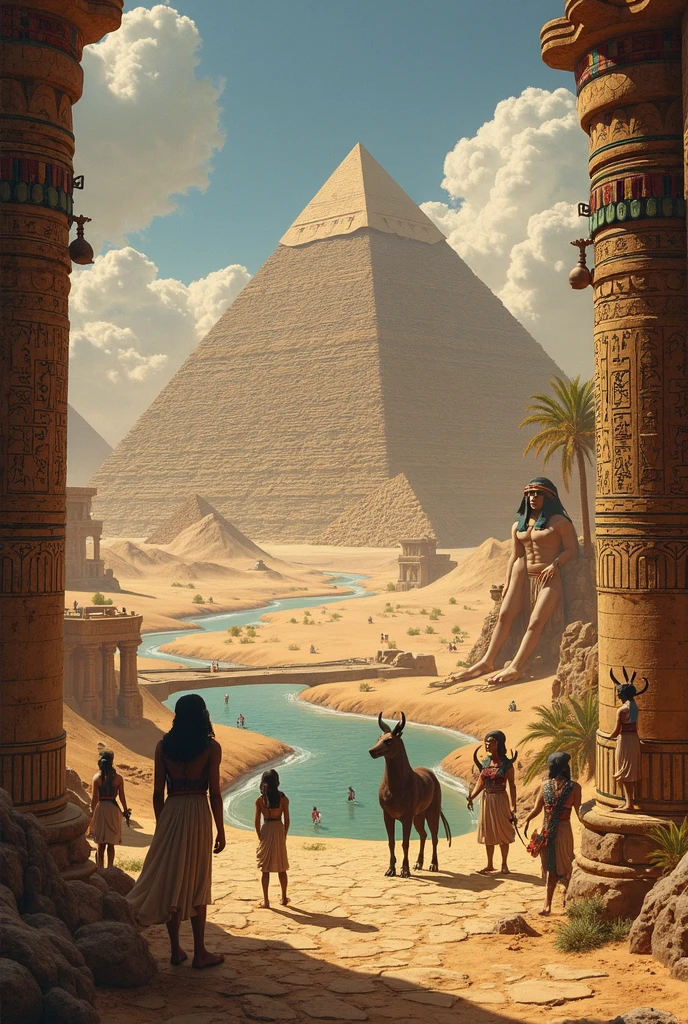Inuit Mythology: The Power of Sedna and the Arctic World
The Inuit people, indigenous to the Arctic regions of Canada, Greenland, and Alaska, have a rich mythology deeply connected to their harsh environment. Among the most important figures in their spiritual beliefs is Sedna, the goddess of the sea and marine animals. Her story is one of tragedy, power, and survival—mirroring the challenges faced by the Inuit in their daily lives.
Who Is Sedna?
Sedna, also known as Taluliyuk or Nerrivik, is a central figure in Inuit mythology. She rules over the sea and all its creatures, controlling the availability of animals like seals, whales, and fish. Her moods dictate the success or failure of hunts, making her both revered and feared by the Inuit.
The Legend of Sedna
There are several versions of Sedna’s origin, but most share common themes:
- Sedna was once a beautiful young woman who rejected all suitors.
- She was either tricked or forced into marrying a bird spirit or a mysterious hunter.
- Her father attempted to rescue her, but in desperation, he threw her into the cold sea.
- As she clung to the boat, her fingers were severed, transforming into the first sea creatures.
This myth explains why Sedna is both vengeful and generous—her severed fingers symbolize the bounty of the ocean, but her anger can withhold food from hunters.
Sedna’s Role in Inuit Life
The Inuit rely heavily on the sea for survival, making Sedna a crucial deity. When food is scarce, shamans must journey to her underwater realm to appease her. They comb her tangled hair (representing the sins of humanity) to calm her anger and restore balance.
| Symbol | Meaning |
|---|---|
| Sea Creatures | Born from Sedna’s fingers, they sustain the Inuit people. |
| Angry Sedna | Causes storms and scarcity of food. |
| Shaman’s Journey | Required to soothe Sedna and ensure hunting success. |
Other Key Figures in Inuit Mythology
While Sedna is vital, other deities and spirits shape Inuit beliefs:
- Nanook – The master of polar bears, influencing hunting luck.
- Agloolik – A spirit that aids fishermen beneath the ice.
- Aurora spirits – Believed to be the souls of the dead dancing in the sky.
The Aurora Borealis in Inuit Culture
The Aurora Borealis, or northern lights, holds deep spiritual significance. Some Inuit believe these lights are the spirits of ancestors playing games, while others warn against whistling at them, as it may invite misfortune.
Shamans: The Bridge Between Worlds
Inuit shamans, or angakkuq, play a crucial role in maintaining harmony between humans and spirits. They communicate with Sedna, interpret dreams, and heal illnesses caused by spiritual imbalance.
| Shaman’s Duty | Method |
|---|---|
| Appeasing Sedna | Spirit journey to comb her hair |
| Healing | Rituals to remove evil spirits |
| Weather Control | Negotiating with spirits for calm seas |
Modern Interpretations of Sedna
Today, Sedna remains a powerful symbol in Inuit culture. Environmentalists draw parallels between her story and modern concerns about overfishing and climate change. Her tale serves as a reminder of humanity’s dependence on nature.
For further reading on Inuit mythology, check out these resources:
- The Canadian Encyclopedia – Detailed articles on Inuit history and beliefs.
- Native Languages of the Americas – A comprehensive guide to indigenous myths.
- Arctic Council – Insights into modern Inuit life and traditions.
Explore more fascinating articles on mythology and culture, and don’t forget to follow us on facebook.com/zatiandrops for daily updates!
Beyond Sedna, the Inuit possess a complex cosmology explaining the origins of the world. Unlike many other mythologies, Inuit creation stories often emphasize transformation rather than creation from nothing. One prominent tale involves Raven (Tulugaak), a trickster deity who shaped the land and brought light to humanity.
The Raven and the First Light
In this myth, the world was initially dark until Raven stole the sun, moon, and stars from a selfish old man who kept them hidden. Raven’s cunning allowed him to trick the man and release light into the world, making life possible for humans and animals alike.
- Raven as Creator: Often depicted as both mischievous and benevolent, Raven molded landscapes and taught survival skills.
- Symbolism: The story reflects the Arctic’s extreme seasons, where light is scarce in winter but abundant in summer.
Comparing Inuit and Norse Creation Myths
| Element | Inuit Belief | Norse Belief |
|---|---|---|
| World Origin | Transformation of existing elements | Formed from the body of Ymir |
| Trickster Figure | Raven (Tulugaak) | Loki |
| Primary Deity | Sedna (Sea Goddess) | Odin (Allfather) |
Spirits of the Land and Sky
The Inuit recognize countless spirits inhabiting natural features. Mountains, ice floes, and even the wind are believed to possess consciousness. Among the most feared are the Tupilaq, vengeful spirits created by shamans to attack enemies.
The Tupilaq: A Double-Edged Weapon
Traditionally, a shaman would craft a Tupilaq from animal parts, bones, and magic. However, if the target’s spiritual defenses were stronger, the Tupilaq could turn against its creator. This underscores the Inuit belief in balance—even supernatural forces must respect natural laws.
To maintain harmony with spirits, the Inuit follow strict taboos (piqujait). Violating these rules risks angering deities like Sedna or Nanook, leading to famine or disaster.
Key Taboos and Their Meanings
- Wasting Meat: Hunters must use every part of an animal to show respect to its spirit.
- Boasting: Claiming superior hunting skills invites misfortune from jealous spirits.
- Mixing Land and Sea: Cooking land and sea animals together offends Sedna.
The Bladder Festival: Honoring Animal Spirits
One of the most significant ceremonies, the Bladder Festival, involves returning the bladders of hunted seals to the sea. Inuit believe the bladders contain the animals’ souls, ensuring their rebirth and future abundance.
The night sky serves as both a spiritual guide and a practical tool for navigation. Constellations like Ullaktut (the Caribou) and Sikuliaq (the Ice Hole) helped travelers traverse the featureless tundra.
Constellations in Inuit Mythology
| Inuit Name | Western Equivalent | Mythological Role |
|---|---|---|
| Ullaktut | Orion’s Belt | Guides hunters to caribou herds |
| Qimmiit | Big Dipper | Represents a team of sled dogs |
| Nanurjuk | Betelgeuse | The polar bear star, linked to Nanook |
Inuit carvings and storytelling preserve mythological knowledge. Soapstone sculptures often depict Sedna with flowing hair or Raven mid-transformation, while throat singing recounts tales of spirits and heroes.
Modern Artists Keeping Traditions Alive
Contemporary Inuit artists like Kenojuak Ashevak blend traditional motifs with modern mediums. Her prints of Sedna and spirit animals have gained international acclaim, bridging ancient beliefs and contemporary art.
- Inuit Art Foundation – Showcasing works inspired by mythology.
- The Met – Features historical Inuit artifacts.
- Smithsonian Magazine – Articles on indigenous Arctic cultures.
Explore more fascinating articles on mythology and culture, and don’t forget to follow us on facebook.com/zatiandrops for daily updates!
The Role of Animals in Inuit Mythology
Animals play a central role in Inuit spirituality, often serving as messengers, guides, or even deities themselves. Unlike Western traditions that separate humans from nature, Inuit beliefs emphasize a deep kinship with the animal world.
The Caribou Spirit: Tuttu
The caribou (tuttu) is more than just a food source—it’s a sacred being with its own spirit. Inuit hunters perform rituals to honor the caribou’s sacrifice, ensuring the herd’s continued abundance. Stories tell of caribou that willingly offer themselves to worthy hunters while fleeing from those who disrespect nature.
- Transformation Tales: Many myths describe humans becoming caribou or vice versa
- Migration Symbolism: The caribou’s seasonal movements mirror the cyclical nature of life
- Taboos: Mixing caribou and sea animal remains is forbidden to avoid offending Sedna
The Moon God: Igaluk
While Sedna rules the sea, Igaluk governs the moon and celestial phenomena. This powerful deity controls the tides, influences fertility, and serves as a judge of human behavior. The lunar cycle’s phases represent Igaluk’s changing moods and judgments.
| Lunar Phase | Interpretation | Cultural Practice |
|---|---|---|
| Full Moon | Igaluk watching closely | Time for important decisions |
| New Moon | Igaluk resting | Avoid beginning new ventures |
| Lunar Eclipse | Igaluk’s anger | Shamans perform appeasement rituals |
The Sun Sister and Moon Brother
One widespread myth explains the celestial bodies’ origins through a tragic incest story. The sun (Malina) flees across the sky to escape her moon brother (Igaluk), creating the eternal day-night cycle. This tale underscores Inuit values regarding family boundaries and natural order.
Underwater Monsters and Land Spirits
The Arctic environment hosts numerous supernatural beings beyond Sedna’s realm. These entities explain natural phenomena and teach moral lessons through cautionary tales.
Qalupalik: The Child-Stealing Spirit
Parents warn children of Qalupalik, a green-skinned creature with long hair and claws who lurks beneath ice holes. This terrifying figure enforces community values by:
- Punishing disobedient children who wander alone
- Explaining sudden disappearances near thin ice
- Teaching respect for the ocean’s dangers
Ijiraq: The Shape-Shifting Trickster
Unlike the benevolent Raven, Ijiraq is a dangerous spirit that leads travelers astray. It can mimic loved ones’ voices or create false landmarks, representing the very real threat of getting lost in the featureless tundra.
Seasonal Myths and Survival Wisdom
Inuit mythology encodes generations of environmental knowledge through stories that track seasonal changes and animal behaviors.
| Season | Dominant Myth | Practical Lesson |
|---|---|---|
| Winter | Sedna’s storms | Store enough food for lean months |
| Spring | Return of the sun goddess | Prepare for seal pupping season |
| Summer | Caribou birth stories | Time for inland hunting |
| Autumn | Raven’s farewell | Finish preparations before winter |
Death and the Afterlife
Inuit beliefs about the afterlife vary by region but share common themes of continuation rather than final judgment. The dead may become northern lights, join Sedna’s court, or be reborn as animals.
The Journey to Adlivun
Most souls travel to Adlivun, Sedna’s underwater realm, where they undergo purification. This process involves:
- A year-long stay on a slippery ice floe
- Tests of patience and resilience
- Possible rebirth if deemed worthy
Mythology in Contemporary Inuit Life
Despite modern influences, mythological traditions remain vibrant through:
- Place names: Many Arctic locations bear names referencing myths
- Education: Elders teach stories to maintain cultural continuity
- Art: Modern media adapt traditional tales for new audiences
For deeper exploration of these living traditions, visit:
- Inuit Circumpolar Council – Advocates for cultural preservation
- ArcticNet – Research on Inuit knowledge systems
- Inuit Knowledge Centre – Digital archives of oral traditions
Explore more fascinating articles on mythology and culture, and don’t forget to follow us on facebook.com/zatiandrops for daily updates!
Inuit Mythology in Modern Storytelling
Contemporary authors and filmmakers increasingly draw from Inuit mythology to create compelling narratives that bridge ancient wisdom with modern audiences. These adaptations often focus on the timeless themes of survival, respect for nature, and the spirit world.
Notable Modern Adaptations
- The Legend of Sarila (2013 animated film) – Features Sedna and other spirits in a coming-of-age story
- Those Who Run in the Sky (2017 novel) – Reimagines shamanic journeys for young adult readers
- Inuit Odyssey (documentary series) – Explores mythological connections to real Arctic archaeology
Gender Roles in Inuit Myths
Inuit mythology presents a complex view of gender that often contrasts with Western stereotypes. While Sedna dominates as a female sea deity, other figures like Nanook (male polar bear spirit) and Igaluk (male moon god) show balanced spiritual power distribution.
| Deity | Gender | Domain | Cultural Significance |
|---|---|---|---|
| Sedna | Female | Sea/Marine Life | Controls food supply |
| Nanook | Male | Land/Polar Bears | Hunting success |
| Agloolik | Non-binary | Under-ice World | Fishing assistance |
Mythological Explanations for Natural Phenomena
The Inuit developed intricate stories to explain environmental occurrences that science would later decode. These myths served as both educational tools and cultural preservation methods.
Why the Sea Is Salty
One widespread tale describes how an old woman’s magical salt container broke at the bottom of the ocean, explaining seawater’s salinity. This story:
- Provided a memorable explanation for children
- Highlighted salt’s importance in food preservation
- Warned against greed (the woman hoarded salt)
Comparative Mythology: Inuit and Other Arctic Cultures
While distinct, Inuit mythology shares surprising parallels with other circumpolar belief systems, suggesting ancient cultural exchanges or universal Arctic experiences.
Common Arctic Mythological Themes
- Sea Goddesses: Similar to Sedna, the Sámi have Čáhcerávga
- Animal Transformation: Also prominent in Siberian Yupik stories
- Star Myths: Many Arctic cultures associate constellations with animal spirits
Climate Change and Mythology
As the Arctic undergoes rapid environmental changes, Inuit elders report that traditional myths are gaining new interpretations. Some view melting ice as Sedna’s anger at human disrespect, while others see shifting animal patterns as spirit messages.
| Environmental Change | Traditional Interpretation | Modern Concern |
|---|---|---|
| Unpredictable sea ice | Sedna’s displeasure | Hunting safety |
| Changing animal migrations | Spirit guidance | Food security |
| New weather patterns | Celestial imbalance | Community resilience |
Mythological Artifacts and Archaeology
Archaeological finds continue to reveal how deeply mythology was woven into daily Inuit life through crafted objects and settlement patterns.
Notable Artifacts
- Tupilaq carvings: Small spirit figures found in ancient campsites
- Shamanic drums: Decorated with cosmological maps of spirit worlds
- Ivory amulets: Worn for protection during dangerous journeys
Language and Mythological Preservation
The survival of Inuit mythology is deeply tied to Inuktitut and other Inuit languages, as many concepts lose nuance in translation. Efforts to document these stories in their original languages include:
- Elder storytelling recordings
- Bilingual children’s books
- Community language revitalization programs
For those interested in linguistic aspects of Inuit mythology:
- University of Quebec’s Arctic Studies – Language documentation projects
- Inuit Cultural Online Resource – Stories in original languages
- Endangered Languages Project – Preservation initiatives
Explore more fascinating articles on mythology and culture, and don’t forget to follow us on facebook.com/zatiandrops for daily updates!


